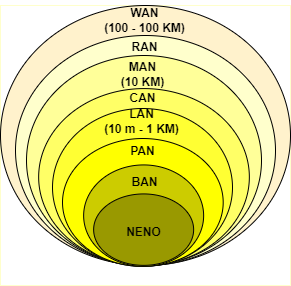NFC is set of communication protocols that enables communication between two electronic devices over a distance of 4 cm or less. NFC offers a low-speed connection through a simple setup that can be used to bootstrap more capable wireless connections. Touch based payment is the examples from our day to day life.
NFC is rooted in radio-frequency identification technology (RFID) which allows compatible hardware to both supply power to and communicate with an otherwise unpowered and passive electronic tag using radio waves.
Let’s begin the discussion from the types of computer networks by scale which can be represented as below image representations as below:

Classifying networks in their physical size as:
- Wide Area Network (WAN)
- Metropolitan Area Network (MAN)
- Local Area Network (LAN)
- Personal Area Network (PAN)
Personal Area Network (PAN) – The interconnection of devices within the range of an individual person, typically within a range of 10 meters. For example, a wireless network connecting a computer with its keyboard, mouse or printer is a PAN. Also, a PDA that controls the user’s hearing aid or pacemaker fits in this category. Another example of PAN is a Bluetooth. Typically, this kind of network could also be interconnected without wires to the Internet or other networks.
Local Area Network (LAN) – Privately-owned networks covering a small geographic area, like a home, office, building or group of buildings (e.g. campus). They are widely used to connect computers in company offices and factories to share resources (e.g., printers) and exchange information. LANs are restricted in size, which means that the worst-case transmission time is bounded and known in advance. Knowing this bound makes it possible to use certain kinds of designs that would not otherwise be possible. It also simplifies network management. Traditional LANs run at speeds of 10 Mbps to 100 Mbps, have low delay (microseconds or nanoseconds), and make very few errors. Newer LANs operate at up to 10 Gbps.
Metropolitan Area Network (MAN) – Covers a larger geographical area than is a LAN, ranging from several blocks of buildings to entire cities. MANs can also depend on communications channels of moderate-to-high data rates. A MAN might be owned and operated by a single organization, but it usually will be used by many individuals and organizations. MANs might also be owned and operated as public utilities. They will often provide means for internetworking of LANs. Metropolitan Area Networks can span up to 50km, devices used are modem and wire/cable.
Wide Area Networks (WAN) – Computer network that covers a large geographical area, often a country or continent. (any network whose communications links cross metropolitan, regional, or national boundaries). Less formally, a network that uses routers and public communications links. Routers will be discussed later.
Near Field Communication (NFC) is a wireless communication technology that enables short-range communication between electronic devices, typically within a distance of a few centimeters (up to around 4 inches). NFC technology is based on radio frequency identification (RFID) and is widely used for various applications, including contactless payments, data exchange, and device pairing. Here are some key aspects of NFC:
- Communication Range: NFC operates over a very short range, making it highly secure for tasks like mobile payments. The close proximity required for communication adds a layer of security as compared to longer-range wireless technologies like Bluetooth or Wi-Fi.
- Operating Frequency: NFC operates at 13.56 MHz and uses electromagnetic induction to establish a connection between devices. This frequency is standardized worldwide.
- Modes of Operation: NFC devices can operate in three modes: reader/writer mode, peer-to-peer mode, and card emulation mode.
- Reader/Writer Mode: In this mode, one NFC device (like a smartphone) can read or write data to NFC tags or cards, such as those used for contactless payments or access control.
- Peer-to-Peer Mode: This mode allows two NFC-enabled devices, like smartphones, to communicate with each other to exchange data. It’s commonly used for activities like sharing files, contact information, or pairing Bluetooth devices.
- Card Emulation Mode: In this mode, an NFC device can emulate an NFC card, allowing it to be used for tasks like contactless payments. This is often seen in mobile payment systems like Apple Pay and Google Pay.
- Applications: NFC technology has a wide range of applications, including:
- Mobile Payments: NFC-enabled smartphones can be used to make contactless payments at point-of-sale terminals, known as NFC payments or mobile wallet payments.
- Access Control: NFC cards or smartphones can be used for secure access control to buildings, parking lots, and other restricted areas.
- Transportation: Many public transportation systems use NFC-based contactless cards or mobile apps for ticketing and fare collection.
- Data Sharing: NFC can be used for sharing files, photos, contact information, and URLs between devices.
- Smart Posters: NFC tags embedded in posters or advertising materials can trigger actions on smartphones when tapped, such as opening a website or downloading an app.
- Security: NFC technology incorporates various security measures to protect data during communication, including encryption and authentication protocols. The short-range nature of NFC also adds a level of physical security.
NFC has become increasingly popular due to its convenience and versatility in various applications, particularly in the realm of mobile payments and contactless interactions. It is supported by a wide range of smartphones and other consumer electronics devices, making it a ubiquitous technology for short-range wireless communication.
Examples of NFC
A few examples of NFC use cases include the following:
- mobile payments, such as Apple Pay and Google Pay;
- transit card payments;
- ticket redemption at a concert or theater;
- access authentication for doors or offices;
- unlocking car doors or rental scooters;
- venue or location check-in to alert friends on social media;
- device pairing smartphones and headsets by tapping them together;
- automatic setup for Wi-Fi connectivity by tapping a phone to a router or internet gateway;
- connection via smartphone to a radiator to configure its temperature settings and schedule; and
- connection via smartphone or tablet to industrial equipment to access a more complex control panel.
Benefits of NFC
NFC has several real-world benefits, including the following:
- increases operational efficiency for payment processors;
- ensures more security than traditional credit cards for payments;
- allows users to choose from multiple cards dynamically;
- difficult to intercept NFC communications from a distance;
- ease of use for consumers in paying for goods;
- simplifies access to back-end information; and
- allows simple setup of new connections compared to other wireless protocols.
Limitations of NFC
Challenges of NFC technology include the following:
- very short range of only a few inches precludes many use cases;
- slower than other protocols;
- can limit usability for apps that require sensitive data on a smartphone;
- app innovation stymied by Apple and Google restrictions and tech implementations;
- not suitable for location tracking; and
- not as universal and easy to integrate into venue ticketing apps as QR codes.
Differences between NFC and other wireless technologies
NFC complements a variety of other wireless technologies, including RFID, EMV (Europay, Mastercard and Visa), Bluetooth, UWB and QR codes. It also differs from these technologies in important ways.
NFC is best suited for authenticating transactions, unlocking doors and configuring other wireless connections. Other technologies work best in the following ways:
- RFID uses readers that can scan simple ID tags at long distances. Because it is unidirectional, this is best for reading toll tags, unlocking doors, authenticating passports or scanning inventory between more active readers and more passive tags.
- EMV allows for credit card transactions using a chip and an equipped payment terminal. While it also authenticates transactions, it is not as dynamic and interactive as NFC, which allows for contactless payments.
- Bluetooth offers a greater connection range than NFC but is less secure. It works best for connecting peripherals, such as headphones, to mobile devices and computers.
- UWB is a new technology and operates at a very low power using pulse patterns to keep from interfering with other wireless technologies. This allows it to send data quickly without losing accuracy. UWB excels in short-range location tracking, which works well for newer use cases, such as wireless car entry.
- QR codes need to be activated by the user by scanning an image with a smartphone’s camera app, instead of a simple tap used by NFC. Businesses can easily generate QR codes for customers to retrieve promotions, product manuals or webpages from printed tags. QR codes are less complex and are easier to include in emails without having to rely on integration with Apple or Google specific functionality.
